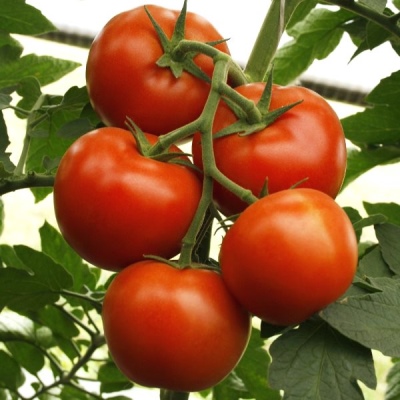
- Authors: Lukyanenko A. N., Dubinin S. V., Dubinina I. N. (Agrofirm Sedek LLC)
- Year of approval: 2017
- Name synonyms: Catherine the Great F1
- Category: hybrid
- Growth type: indeterminate
- Appointment: fresh consumption
- Ripening period: mid-season
- Ripening time, days: 110-115
- Growing conditions: for open ground, for film greenhouses
- Marketability: high
A rather young and unpretentious medium-ripening variety Catherine the Great is a hybrid of the first generation of domestic selection. The plant is tall, therefore it is recommended to grow in tall greenhouses or in the open field. Tomatoes grow large and mouth-watering, indeed, worthy of bearing the name of the great Russian queen.
Breeding history
The authors of the tomato Catherine the Great became the general director of LLC "Agrofirma Sedek" Dubinin S.V and scientists (Lukyanenko A.N., Dubinina I.N.). The hybrid is included in the State Register in 2017. Synonym for the variety name Catherine the Great F1.
Description of the variety
Catherine the Great is a tall, large-fruited hybrid. The height of the bushes is from 2 to 2.5 m. The growth rate is indeterminate. Strong plant, slightly elongated leaves, dark green. The inflorescence is simple. Each cluster usually contains 5-6 ovaries. Tomatoes in a bunch are closely spaced to each other. Despite the fact that the mass of all fruits in each cluster is more than 1.5 kg, the stems can withstand a lot of weight and do not break. Suitable for growing in private plots in the open field or in greenhouses: both normal and winter, year-round use.
Excellent presentation, transportability and keeping quality of fruits for several months make it a welcome guest on store shelves. Suitable for fresh consumption and canning.
The main qualities of the fruit
Unripe fruits are light green. Ripe tomato color is uniform, red. The skin is dense, slightly glossy. Fruits are flat-round, large, weighing 220-320 g.
Taste characteristics
The color of the fruit and pulp is red, the seed chambers are clearly visible on the cut. The fruits are juicy, fleshy, with a sweet and sour classic tomato flavor.
Fruits that have ripened on the bush taste sweeter than those harvested brown or green.
Ripening and fruiting
Mid-season tomato. After the appearance of the cotyledon leaves, it takes about 100-115 days until the fruits of Catherine the Great ripen. In the open field, harvesting is carried out until the first days of August.
Yield
The yield of Catherine the Great is above average - about 16.2 kg / sq. m.
The timing of planting seedlings and planting in the ground
Sowing seeds for seedlings is carried out in early March. After the appearance of real leaves, the plant is transplanted into separate containers. Young plants require additional artificial lighting in the morning and evening.

Growing tomato seedlings is an extremely important process, because it largely depends on whether the gardener will be able to harvest at all. All aspects must be taken into account, from seedbed preparation to planting in the ground.
Landing scheme
When a plant is formed into 1 stem, a distance of about half a meter is left between the plants, if in 2 stems, then about 0.7 m.The row spacing should be at least 70 cm.

Growing and care
Since the plant is indeterminate, it needs a garter. Supports must be installed. During the growing season, the bushes are tied up several times.
Over-watering should be avoided. When grown in greenhouse conditions, it is imperative to ventilate.
After the first fruits have set on the lower brush, all the leaves below are cut off. The same procedure is carried out with subsequent brushes.




A plant needs different micronutrients at each stage of growth. All fertilizers can be divided into two groups: mineral and organic. Folk remedies are often used: iodine, yeast, bird droppings, eggshells.
It is important to observe the rate and period of feeding. This also applies to folk remedies and organic fertilizers.
Disease and pest resistance
Catherine the Great is resistant to many diseases and cracking of ripe fruits.
Verticillosis, cladosporium disease, tobacco mosaic virus are not terrible for these tomatoes. The plant requires preventive treatments for late blight.


Resistant to adverse weather conditions
Possesses stress resistance at sudden temperature changes.
Growing regions
Most of the territory of the Russian Federation is suitable for growing. Can be cultivated in the following regions:
Far Eastern;
Ural;
East Siberian;
West Siberian;
Volgo-Vyatsky;
Central Black Earth Region;
Nizhnevolzhsky;
Middle Volga;
central;
North Caucasian;
northern;
northwestern.
Review overview
Reviews of gardeners about this variety are a bit ambiguous. Among the advantages are the unpretentiousness of the plant, long-term storage, large fruits and resistance to many diseases.The biggest disadvantage is that the taste of the fruit is “for everybody”. Many people compare it to the taste of "plastic" tomatoes that are sold in stores in winter.

























































































